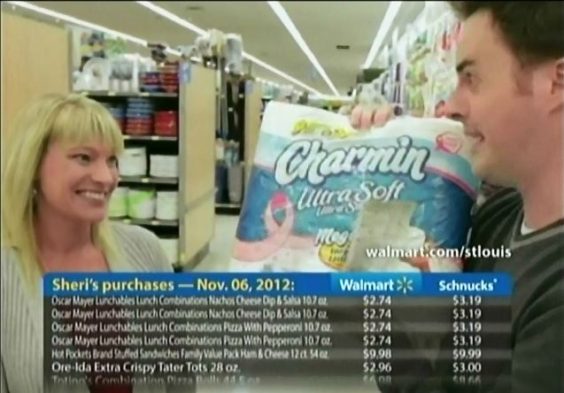
Nearly a year into Walmart’s advertising campaign that puts its grocery competitors’ prices in the crosshairs, one grocery chain is fighting back. St. Louis-based Schnucks is demanding that Walmart “cease, desist and refrain” from what it calls “deceptive and misleading” advertising. Schnucks’ allegations, and Walmart’s responses, also pull back the curtain a bit on how Walmart’s ads are produced, and who exactly is selected to appear in them.
In December, Best Buy and Toys “R” Us filed complaints with a number of state attorneys general, arguing that Walmart’s price comparison commercials were unfair and inaccurate. The Wall Street Journal reported at the time that it was told at least one unidentified “regional supermarket chain” had also complained.
Documents obtained exclusively by Coupons in the News now show that Schnucks has issued formal complaints not only to the Illinois Attorney General’s office, but also to Walmart itself.
In a letter to Walmart dated November 9th, Schnucks demands that Walmart stop running TV and newspaper ads that compare Walmart’s prices to Schnucks’. Since early last year, the “Market Basket Challenge” campaign has featured localized ads running in dozens of cities, in which a local competitor’s prices are compared to Walmart’s. The ads’ premise has a (usually female) person identified as a “real shopper” buying items she would normally purchase at her preferred grocery store, then buying the exact same items at Walmart and comparing the receipts side by side. Unsurprisingly, the Walmart ads end with Walmart winning the challenge every time. One ad that ran in the St. Louis viewing area (which includes parts of Illinois) in November showed that “Sheri” saved 20% on the items she purchased at Walmart, as compared to the same basket of items purchased at Schnucks.
But Schnucks says the commercials are misleading and even willfully deceptive. “The overall net impression of the ad and the only reasonable consumer takeaway is that Walmart’s prices are 20% lower than Schnucks’ on a store-wide basis,” Schnucks’ complaint to Walmart reads. Schnucks also alleges that, despite the fact that the ads purport to show real shoppers’ real purchases, the items compared do not represent a typical, representative sample of groceries and prices. Meat and produce, “two categories that represent key components of the typical grocery purchasing experience”, are excluded from the comparisons, and that fact is only disclosed in what Schnucks calls “Lilliputian print” in a disclaimer that must be “viewed with a microscope.” The grocery chain further questions how participants in the ads were selected and whether they were manipulated into buying items for which the prices favored Walmart, since some items with the biggest price discrepancy were purchased in multiples, thereby inflating the overall percentage saved. Schnucks ends its complaint with a demand that Walmart put a stop to the ad campaign.
In its response to Schnucks, Walmart refuses to stop running its ads, noting that Schnucks never actually complains that the prices shown are incorrect. “Truthful, accurate and substantiated price comparison advertising is lawful and helps consumers,” Walmart says, adding that “we understand that Schnucks may wish to silence these price comparisons because its prices for the items were higher than at Walmart.” Meat and produce items are excluded, Walmart explains, because it’s simply not possible to make direct price comparisons of random-weight items. Otherwise, it says, all items shown were selected by the shoppers themselves – not by Walmart.
In a followup letter, Schnucks demands further information about how the shoppers featured in the ads are selected. Walmart’s answers, and various casting calls published across the country over the past year, provide some interesting insights into the process. Classified ads seeking potential participants have asked for “real everyday moms and dads between the ages of 28-45,” “normal-looking Middle America types” who “have a big personality and are able to give good, authentic reactions on camera.”
Walmart explains to Schnucks that “Sheri”, one of the shoppers featured in its St. Louis ad campaign, was chosen “through a standard selection procedure.” She “is an ordinary St. Louis-area consumer and mom” who is not a regular Walmart shopper and had no idea how the prices for the items she bought at Schnucks would compare to those at Walmart. “She had no basis to ‘game’ the comparison by loading up on multiples of items that were less expensive at Walmart.” Walmart says Sheri was instructed not to buy alcohol, tobacco or lottery tickets, and was told to “purchase items that she would normally purchase in the quantities she would normally purchase them.” Otherwise, Walmart says, she selected her purchases herself, including some items that were on sale and were cheaper at Schnucks, and she neither told Walmart what she planned to buy or was told what to buy. Once any random-weight products were removed from the comparison, “immediately after the items were purchased at Schnucks, as depicted in the ad, Sheri brought the items and her grocery receipt to Walmart… and the commercial was filmed shortly thereafter.”
Soon after this back-and-forth, Walmart ran another ad, featuring “Chelle”, who was shown to have saved 13% at Walmart after purchasing the same items at Schnucks. Schnucks then issued a final demand that Walmart end the ads, and issued a separate complaint to the Attorney General’s Office in Illinois, where it has several stores. The ads are “unlawful”, it claimed. “Any percentage price comparison over a limited number of selected items is inherently deceptive and misleading” because “they create the false impression that the price disparities shown are typical and resulted from a random selection of products and consumers.” The complaint goes on to say that Walmart has refused to provide “meaningful information” about how the shoppers featured were selected.
Schnucks is not the first grocery store to push back against Walmart’s price-comparison ads, but it may be the first to file a formal complaint to that effect. In August, Milwaukee-based Pick ‘n Save launched its own ad campaign, emphasizing its own quality and service in an effort to “change the discussion from price only” (read: “The Walmart Challenge: A Competitor Fights Back”). And in September, Florida-based Publix began publishing its own price comparisons, focusing on its lower-priced sale items (read: “‘See For Yourself’, Indeed”). And of course, Best Buy and Toys “R” Us have filed a number of complaints with various state attorneys general, arguing that Walmart’s prices in some ads were just plain wrong (read: “Legal Challenges to the ‘Walmart Challenge'”). Other defenders of grocery stores featured in Walmart’s ads have pointed out that, by shopping sales and using coupons that Walmart doesn’t double, shoppers could save just as much, if not more, at the grocery store. In fact, most Schnucks locations offer double coupons, and often run triple-coupon promotions.
Curiously, Schnucks’ complaints mention none of this. They don’t dispute the prices shown, and don’t detail how they provide value in other ways. The basis of their challenge is the very premise of the ad campaign itself, and the overall impression it makes. Schnucks cites a 2004 decision by the National Advertising Division, a unit of the Advertising Self-Regulatory Council. In that decision, the NAD examined a price comparison conducted by Tops Friendly Markets of New York. In one of its stores, Tops displayed two shopping carts full of products, one purporting to be purchased at Tops, the other at competitor Giant Eagle, each with a total price attached. The NAD noted that Tops described the items as reflecting a typical shoppers’ purchases, but claimed its promotion did not suggest that the savings were typical of those that any other shopper could expect to enjoy. The NAD concluded that the comparison was misleading, because a “reasonable consumer takeaway is that the advertiser’s prices are substantially lower than its competitors’ on a store-wide basis.”
Walmart cites the very same NAD report, which does not object to any “item by item comparison so long as the comparison clearly refers to any deleted items and does not imply that the comparative price savings are storewide.” Tops hand-selected the items it compared, and didn’t include line-by-line price comparisons. In contrast, Walmart notes, it didn’t select the items to be compared, it displayed each individual price side by side, and it insists that the comparison makes no suggestion about the prices of other products and other potential savings. The ads also invite viewers and readers to bring their own receipts to Walmart to try comparing prices themselves. Walmart even offered an online “Receipt Comparison Tool” last year, in which shoppers could submit their grocery receipts online (read: “Walmart Kicks Its Challenge Up a Notch”). Those whose grocery store purchases turned out less expensive than the same items at Walmart were told that Walmart’s ad match guarantee meant the worst they could do at Walmart was break even.
What of the allegation that the featured shoppers are manipulated in some way, even if Walmart didn’t instruct them on what to buy? Casting calls for the commercials note that applicants who are selected to appear will receive “a $500 gift card and the experience of a lifetime.” Schnucks complains that, “even assuming that Walmart did not steer the ‘real’ customers in a certain purchasing direction designed to increase the price savings, it certainly motivated them to select items that they knew or believed would favor Walmart to increase their chances of making $500.” Walmart denies any manipulation, though it didn’t say whether any ads were filmed and never aired, because those particular shoppers didn’t see a big price savings (or whether those shoppers got their $500 gift card).
The Illinois Attorney General’s office wouldn’t comment on the status of Schnucks’ complaint, whether it’s being investigated or whether any action will be taken. The Attorney General’s office in Schnucks’ home state of Missouri indicated that it had also received complaints about Walmart’s ads, but as of this writing has not confirmed whether any of the complaints came from Schnucks. When contacted for further comment, both Walmart and Schnucks referred to earlier statements they gave Coupons in the News. “We believe the ads were unfair and misleading,” Schnucks spokesperson Lori Willis said last month. “Our focus remains on our customers and in continuing to deliver the combination of quality, service AND value that counters this type of campaign.”
Update: After other media outlets picked up Coupons in the News’ story, Willis confirmed Thursday that Schnucks had indeed filed a complaint with the Missouri Attorney General’s office as well. In a new statement, Willis restated many of the points made in Schnucks’ complaints, but added that “the comparisons did not take into account additional savings available at Schnucks through advertising offers, special buys and double and triple coupons offers.” In addition, the statement noted, “we absolutely want customers to compare prices, products and service in their search to find value; however, they deserve accurate and non-misleading information from which to base their choices on where to shop.”
Walmart spokesman Steven Restivo stuck by his earlier statement, that Walmart is “confident in the legal, ethical and methodological standards” used in creating its ads. “Consumers appreciate being educated about where to find the best value in their community. We know competitors don’t like it when we tell customers to compare prices and see for themselves but we think consumers deserve every chance to find value.”
Schucks may complain, Walmart may exude confidence, and the authorities may yet weigh in to decide whether the two retailers are fighting fair. But ultimately, it’s up to the consumers to choose where they’ll do their shopping, which in the end will determine who really wins the “Walmart Challenge”.











I certainly save way more at Schnucks. I guess it depends if you use coupons. Today I bought $80 worth of groceries at Schnucks for $6.66 after triple coupons. The double and tripling accounted for $31 of my savings.
Pingback: Schnucks Says Walmart Doesn't Play Fair | StLMotherhood
I’m not sure why they’re complaining…Walmart certainly seems cheaper to me. And I don’t think it’s fair to say you have to chase coupons on double & triple coupon day to catch a break at Schnucks.